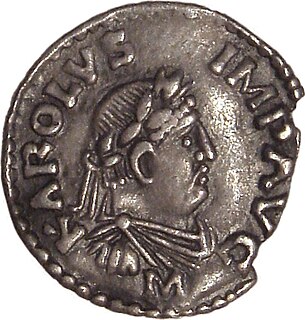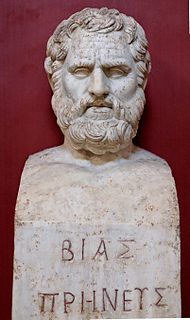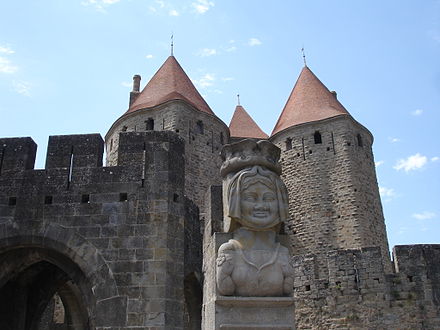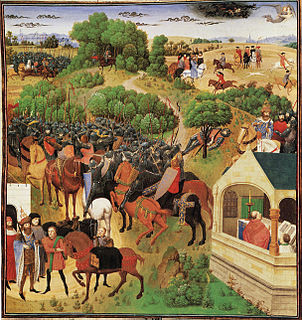
The chanson de geste is a medieval narrative, a type of epic poem that appears at the dawn of French literature. The earliest known poems of this genre date from the late eleventh and early twelfth centuries, before the emergence of the lyric poetry of the trouvères (troubadours) and the earliest verse romances. They reached their apogee in the period 1150–1250.

Bertrada of Laon, also known as Bertrada the Younger or Bertha Broadfoot, was a Frankish queen. She was the wife of Pepin the Short and the mother of Charlemagne, Carloman and Gisela.

Rennes-les-Bains is a commune in the Aude department in southern France.

The pas d'armes or passage of arms was a type of chivalric hastilude that evolved in the late 14th century and remained popular through the 15th century. It involved a knight or group of knights who would stake out a traveled spot, such as a bridge or city gate, and let it be known that any other knight who wished to pass must first fight, or be disgraced. If a traveling venan did not have weapons or horse to meet the challenge, one might be provided, and if the venan chose not to fight, he would leave his spurs behind as a sign of humiliation. If a lady passed unescorted, she would leave behind a glove or scarf, to be rescued and returned to her by a future knight who passed that way.
Medieval French literature is, for the purpose of this article, literature written in Oïl languages during the period from the eleventh century to the end of the fifteenth century.
La Geste de Garin de Monglane is the second cycle of the three great cycles of chansons de geste created in the early days of the genre. It centres on Garin de Monglane.

Fierabras or Ferumbras is a fictional Saracen knight appearing in several chansons de geste and other material relating to the Matter of France. He is the son of Balan, king of Spain, and is frequently shown in conflict with Roland and the Twelve Peers, especially Oliver, whose prowess he almost rivals. Fierabras eventually converts to Christianity and fights for Charlemagne.
The Council of Saint-Félix, a landmark in the organisation of the Cathars, was held at Saint-Felix-de-Caraman, now called Saint-Félix-Lauragais, in 1167. The senior figure, who apparently presided and gave the consolamentum to the assembled Cathar bishops, was papa Nicetas, Bogomil bishop of Constantinople.
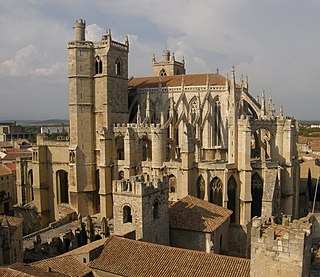
The former Catholic diocese of Narbonne existed from early Christian times until the French Revolution. It was an archdiocese, with its see at Narbonne, from the year 445, and its influence ran over much of south-western France and into Catalonia.

The Roman Catholic Diocese of Nîmes is a diocese of the Latin Rite of the Roman Catholic Church in France. The diocese comprises all of the department of Gard. It is suffragan of the Diocese of Avignon.

The Roman Catholic Diocese of Carcassonne and Narbonne is a diocese of the Latin Rite of the Roman Catholic Church in France. The diocese comprises the entire department of Aude. It is suffragan to the Archdiocese of Montpellier.

Li coronemenz Looïs, or Le coronement Looïs is an anonymous twelfth-century Old French chanson de geste. It is sometimes attributed to Bertrand de Bar-sur-Aube and dated 1137. The first modern critical edition of the text was published in 1888 by Ernest Langlois under the title Le Couronnement de Louis.
Aymeri de Narbonne is a legendary hero of Old French chansons de geste and the Matter of France. In the legendary material, as elaborated and expanded in various medieval texts, Aymeri is a knight in the time of Charlemagne's wars with the Saracens after the Battle of Roncevaux Pass. He is son of Hernaut and the grandson of Garin de Monglane. He conquers the city of Narbonne, marries a princess named Hermengarde or Hermenjart, and fathers seven sons, the most famous being Guillaume d'Orange, the hero of several popular chansons de geste.
Entrée d'Espagne or L'Entrée d'Espagne or Entrée en Espagne is a 14th-century (c.1320) Franco-Venetian chanson de geste. The author is thought to be from Padua. The work has survived in only one manuscript, today in the Biblioteca Marciana in Venice. Based on material from the Pseudo-Turpin Chronicle and several other sources, the epic poem tells of Charlemagne's battles in Spain and the adventures of the paladin Roland.
Jules-Romain Tardieu was a French writer, publisher and bookseller.
Aiquin, subtitled La conqueste de la Bretaigne par le roy Charlemaigne, is a medieval Old French chanson de geste about the rivalry between a Saracen king, Aiquin, and the Christian emperor Charlemagne. The French medievalist Joseph Bédier called it a "consolidation of history and legend in an imposing ensemble." It survives in one fifteenth-century manuscript, BnF fr. 2233, now in the Bibliothèque nationale de France. It is usually attributed to Garin Trosseboeuf, possibly a cleric of Dol, and was probably written in the late twelfth century. It is the oldest extant French text from Brittany.
Anne Berthelot is a French professor of Medieval French literature and studies. She is currently teaching at the University of Connecticut since 1990.



